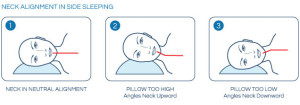Are you going to sleep feeling good and waking up with neck and /or back pain? I don’t think a week goes by that a client doesn’t ask me advice on sleeping habits and what pillow they should be using.
Rest and sleep are the body’s chance to heal itself from the postural, physical and nervous system stressors from the previous day. I will try and outline some things to consider in regards to sleep posture and pillows so that you can take steps to improve the quality of rest and repair you need to allow yourself to wake up more rested and ready to face another day.
First question that you need to ask, is what kind of sleeper are you?
BACK SLEEPER? If you sleep on you back, a small pillow under the back of your knees will reduce stress on you spine and support the natural curve in you lower back. The pillow for your head should support your head. the natural curve of your neck, and your shoulders.
When sleeping on the back, the height of the pillow should be lower than in the side lying position.
SIDE SLEEPER? If you sleep on your side, a firm pillow between your knees will prevent your upper leg from pulling your spine out of allignment and reduce stress on your hips and lower back. Pull your knees up slightly toward your chest. The pillow for you head should keep your spine straight. A rolled towel or small pillow under your tummy/waist may also help support your spine.
When lying on your side, a pillow should support the head and neck such that the spine maintains a straight and natural horizontal line. Weight should be evenly distributed so as not to create unnatural bending or pressure.
TUMMY SLEEPER? If you sleep on your stomach, it can create stress on the back because the spine can be put out of alignment. You can place a flat pillow under the stomach and pelvis area. This will help to keep the spine in better position or spinal alignment.
When lying on your stomach, a pillow for your head should be flat, or sleep without a pillow. This is to prevent the head and neck to be turned unnaturally to either side.
Important things to keep in mind:
- Insert pillows into gaps between your body and the mattress
- when turning in bed, remember not to twist or bend at the waist but to move your entire body as a unit. Keep your belly pulled in tight, and bend your knees toward your chest when you roll…..Yes I know you are half asleep and can’t control it, but keeping it in mind will slowly let you adapt for it to become second nature!
- Keep your ears, shoulders, and hips aligned when turning as well when sleeping
Summary:
Try and use a variety pillows for both comfort and support – this can make a big difference in alleviating or avoiding back pain and getting a restful sleep.
If you have a spinal disorder, it is so important for you to find the right type of support in order to let your spine rest comfortably.
A firmer pillow can offer better support for those with spinal issues such as disc degeneration, or spinal stenosis. A soft down or feather like pillow doesn’t give much support compared to those filled with firmer materials
Pillows filled with grain or buckwheat hull are often effective as well for people with any of the above conditions.
Not all pillows work well for everyone. A short trial of one week should be enough time to decide whether or not the pillow is right for you and is providing benefit. Pillows should also be replaced at least every 12-18 months otherwise they lose their structure and form.
Happy Sleeping!
Articles Referenced:
Spine-Health.com
The Univesity of Utah “Good sleeping posture helps your Back”



